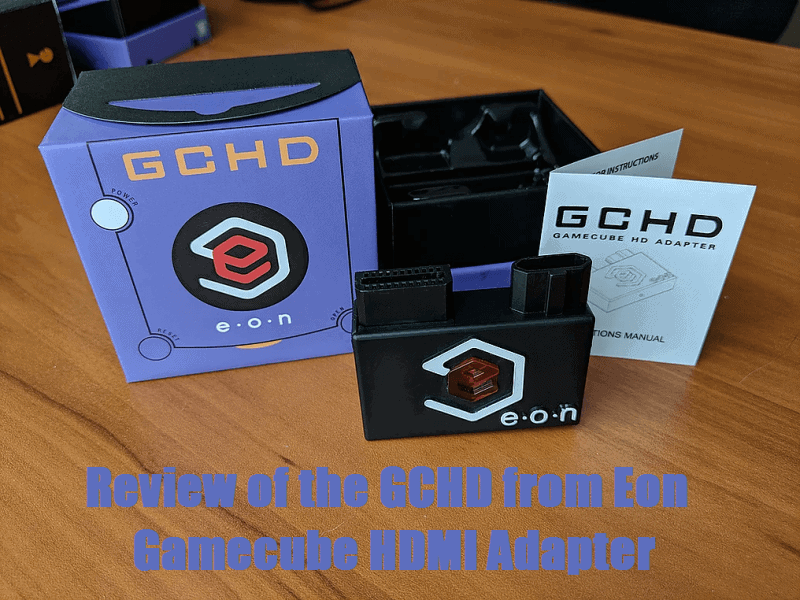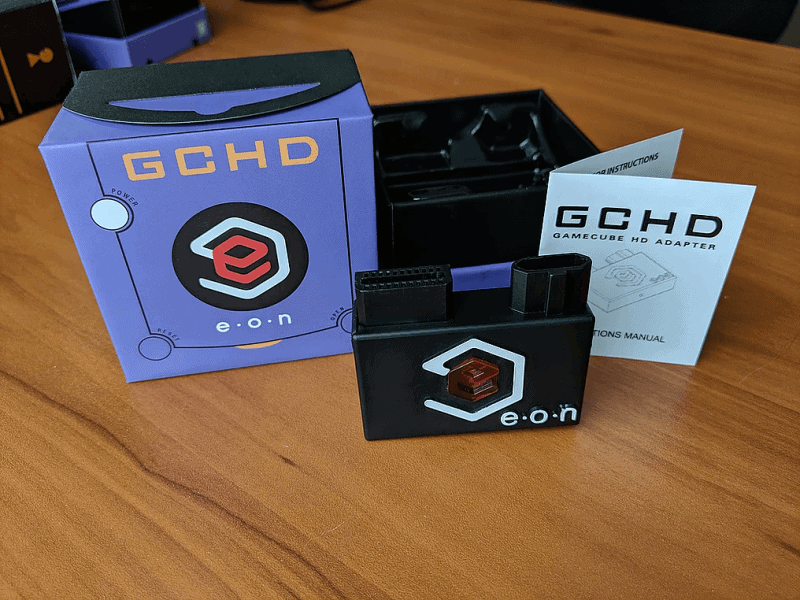As we march further along in time, there are artifacts that linger from the past. One such magnificent relic is the Nintendo Gamecube. If you want to play the Gamecube on a modern HDTV you’ll find that there are a couple of officially supported methods. You can use composite that comes with the Gamecube, pay $300 for component cables for the Gamecube, or play composite/component on the Wii. Up to now, the third option makes the most sense. Purists would love to buy the component cables for the Gamecube, but it’s just too much moolah. However, despite all that, we now are starting to see HDMI adapters appear for the Gamecube. One such product is the GCHD ($149.99, Eon). Is it worth it since it’s cheaper than the official Gamecube component? Let’s take a look!
Here is a quick description of the GCHD:
‘GCHD is a no-mods required HDMI converter that allows real Gamecube hardware to produce the highest native resolution possible on any HDTV while eliminating all input lag. Simply plug GCHD into a compatible Gamecube console (Model DOL-001), attach an HDMI cable, and enjoy true 640x480p progressive scan. These resolutions have previously been locked behind rare and expensive Gamecube component cables, but no more! GCHD is the simple, reliable, and affordable solution for getting the best experience possible using real Gamecube hardware.’
And a list of features:
- ‘Highest Native Resolution: Get the most out of your Gamecube with true 640x480p through the Gamecube’s Digital AV port. Powered by GCvideo.
- Lagless Input: Enjoy seamless gameplay on HD displays without the typical high latency associated with analog to digital setups.
- Plug and Play: Simply plug the GCHD into a compatible Gamecube and you’re ready to go!
- Professional Grade Construction: Only the best components including top quality chips, boards, and custom tooled fittings
- Custom Dual Prong Design: GCHD’s dual prong design allows for secure, worry-free connections that will never damage your system.
- Fully Customize Your Experience: Sync any universal IR remote to GCHD to access a full menu of options including scan lines and line doubling.’
A gameplay video:
And finally, an unboxing video:
Hardware/Structural Stability:
This piece of tech for the Gamecube is a very small accessory. On the top is the eon logo and the big logo for the GCHD itself. Then on the front side of the device is the IR receiver sync button. On the bottom and right side, there’s nothing to look at. But on the left side you have the HDMI out port. And on the back of the device you’ll find both plugs side by side. One is for the standard AV output port the other is for the digital output port.
Now, if you actually look at the device, you’ll find it’s damn strong. The plastic they use is ultra sturdy and can’t be bent and isn’t squishy. You’ll notice that the two plugs are slightly off center. This is to help make you really have to force it in. The GCHD is a very solid device and for what it’s worth, I can’t imagine it will give up on you. I’m certain that if you leave it in once you’ve plugged it in, it will last the life of your Gamecube.
Game Compatibility:
To address the elephant in the room, no, this won’t make every single game that you have look like it’s in 1080p or something. It can’t work magic. What it will do is take any game that uses Progressive Scan and then it will pass the game through to your HDTV in the highest definition that said specific game can output. Any other game that doesn’t use Progressive Scan will be sent through at it’s default definition, just with the straight textures. So in some instances this is great. In other instances, they don’t look so great. Like when the game dev took some shortcuts knowing that they wouldn’t be visible on tube and CRT TVs. In other words, loads of jaggies. Like, more jaggies than I have ever seen from any PS1 emulator. But all in all, an amazing amount of games are compatible with this. The ones that aren’t still look a multitude better than what you get over composite.
Please watch these 3 game videos for visual comparisons across three separate games (I removed the audio as to not alarm Nintendo):
Device Compatibility:
This compact HDMI adapter is only for the first models made by Nintendo. If you have a DOL-001 model with the digital output port, you’re set. The digital output port is what is used for the video output. The system will recognize if you have something plugged into the port. If you do, it will ask if you would like to play in Progressive Mode. You can always choose not to play in Progressive Mode too. Some games may be a little less “sharp” if you play non-Progressive Mode through HDMI. It’s all user preference and can be set per game. If you ever want to change it, hold the B button right after the initial Gamecube boot screen.
Features?:
So do the features that Eon advertises quite a lot of features. Let’s look through them all and I’ll inform you as to whether or not they’re present in the final product. The first mentioned feature is that the device gets you the highest definition from a game as it’s powered by GCVideo. And, I would definitely agree as you always are given the definition in the corner whenever a game loads. It touts 640×480 and it’s always either that or just under that. I think there are some games that don’t allow for full 480, but it’s a rarity.
The next feature is lagless input while still maintaining the HD signal. I tested fast paced twitch type games and I was not disappointed. From games like Mario Kart Double Dash to Tetris, these games are reliant on it. I didn’t notice a single difference. If there is one, we’re talking like a single frame’s difference, nothing that is going to impact gaming. Moving on, the next feature on the list is the Plug and Play nature of the device. And it’s true, you plug it in and play. However, you have to feel it really pop into place. If you’ve applied enough force, you’ll hear that pop. Once you do that, you’re set.
The last three features are the professional construction, custom dual prong design, and the IR setting support. I already talked about how this device is made of great material and how durable it is. The dual prong design helps it stay inside and can’t bend out of place. With regards of the IR remote support to access the settings of the device, I would advise that you don’t bother. It’s going to be just fine with the settings built into it. It’s really going to be for any video enthusiast. But yes, it does work, I just didn’t find my use to it.
 Overall Thoughts:
Overall Thoughts:
This product is just the best product that I’ve reviewed in a long while. It does what it said it will do and it does it in a compact way. Whats more, it comes with additional, customization features. This is something you can’t get on some lesser cost products that enable HDMI on the Gamecube. Is all of everything that we talked about worth the $150 price point though? I think that that depends on you.
If you’re a purist that only wants to play on the system, this is worth the money, most definitely. This thing is the next logical step for retro video game collectors that can’t logically have a big hefty expiring CRT. It helps enable the end user to have the older system in the living room.
Now if you’re thinking that it’s cheaper and just as good just to use the Wii and use component cables, that’s technically incorrect. It doesn’t detect the component the same way that the Gamecube does. Meaning, it won’t prompt you for the Progressive Scan. The same could be said if you use the Wii HDMI adapter. However, if you see the $150 price as a problem, playing on the Wii with an HDMI adapter may be the next best thing. But again, I just don’t recommend it. Those are more for the people who bought HDTV’s that don’t have any composite or component ports.
The GCHD by Eon has my vote. It took me from be a pessimist and turned me back onto collecting for the Gamecube!
Bonus Video, Footage of Various GBA games in the Gameboy Player:
To purchase the Eon GCHD, you can get it from Castlemania or PayPal.
If you like the author’s work follow him on Twitter @V1RACY
And as always, stay tuned here on Hackinformer.com for so much more and follow us on Twitter @Hackinformer





